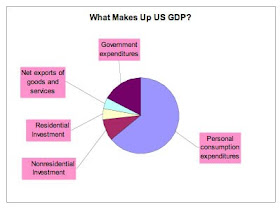
In the September 17, 2009 article "
Consumer Spending Likely To Rise In Q3, But Outlook Cloudy," Scott Stoddard reports that government macroeconomic stimulus policies have increased consumer spending and aggregate demand:
Gains in retail sales, home purchases and household wealth are bolstering views that consumer spending has stabilized after weighing on the economy for a year. But analysts warn that outlays could remain tepid for two years, making for a sluggish recovery.
Consumer spending, which accounts for about 70% of GDP, is set to rebound sharply in Q3 thanks mainly to government tax breaks and incentives, such as the Cash for Clunkers program that fueled auto sales. Experts say the economy could grow 3% or more in July-September after shrinking for four straight quarters.
But as federal stimulus spending wanes, the economy may struggle to maintain momentum as Americans are pressured by debt, tight credit and a weak labor market.
"The big concern for me is 2011," said Scott Brown, chief economist at Raymond James. "Hopefully, the private sector will be back on its feet and moving forward to offset the decreasing fiscal stimulus."
In a positive sign, household wealth rose by $2 trillion in Q2 to $53.1 trillion as stock values rebounded, the Federal Reserve said Thursday. It was the first gain since Q3 2007, when wealth peaked at $65.3 trillion.
"We're beginning to turn the tide," Richard DeKaser, chief economist at Woodley Park Research, said before the report. "But we have some ways to go before we completely recoup the losses of the last few years."
Housing starts and building permits also rose in August on strong demand for multifamily units, the Commerce Department said.
Adding to signs that the recession has ended, the Philadelphia Fed's index of business sentiment jumped 9.9 points in September to 14.1, a two-year high.
Economists caution, however, that the U.S. could experience a double-dip recession if unemployment and tight credit force consumers to curb spending.
Households trimmed debt at a 1.7% annual rate in Q2 while consumer credit plunged at a 6.5% rate, the Fed said, as Americans focused on paring debt and rebuilding savings.
The number of workers filing new claims for unemployment benefits dropped by 12,000 last week to 545,000, the lowest since early July, the Labor Department said Thursday.
But the number of people still on jobless rolls after an initial week of aid rose by 129,000 in the week ended Sept. 5 to 6.23 million, indicating that employers remain reluctant to hire. The jobless rate, already at a 26-year high of 9.7%, is expected to top 10%.
"We need to see income growth go back up and people need to feel more certain about their job prospects" before they feel confident enough to boost spending, said Mark Vitner, an economist at Wells Fargo Investments.
Big-ticket goods such as autos will probably bear the brunt of consumer cutbacks, analysts said.
A Bloomberg News survey on Thursday showed that almost a third of U.S. households plan to trim spending while 58% expect no change amid concern about the economy over the next six months. Just 8% of households plan to increase spending, the survey showed.
Vitner said that a double-dip recession was unlikely but that economic growth would likely taper off next year after the expiration of stimulus measures such as the $8,000 first-time homebuyer tax credit and Federal Reserve efforts to keep mortgage rates low.
"We're likely to see a relatively sluggish recovery," he said.
 In the September 17, 2009 article "Consumer Spending Likely To Rise In Q3, But Outlook Cloudy," Scott Stoddard reports that government macroeconomic stimulus policies have increased consumer spending and aggregate demand:
In the September 17, 2009 article "Consumer Spending Likely To Rise In Q3, But Outlook Cloudy," Scott Stoddard reports that government macroeconomic stimulus policies have increased consumer spending and aggregate demand:
The consumer is finished.
ReplyDelete